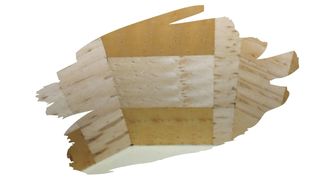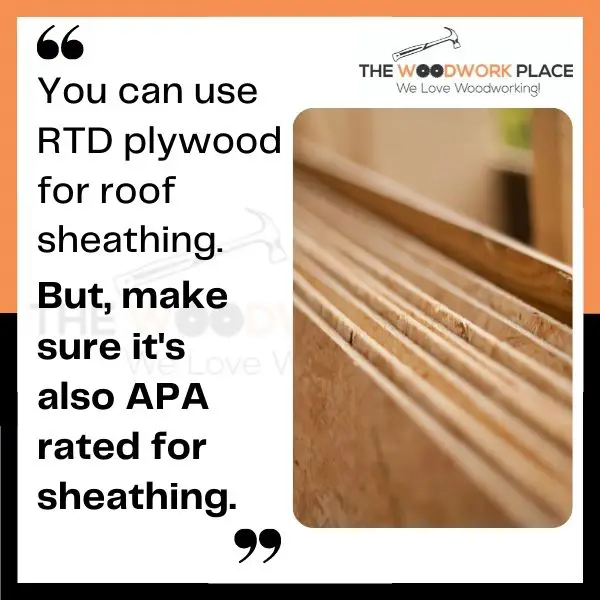When it comes to roof sheathing, you need to use material that is light, strong, and moisture-resistant.
That’s why, time and again, Exterior Graded Plywood comes out on top, as one of the most reliable options for sheathing.
Slightly more expensive than OSB sheathing, the extra cost is worth it. Especially when you consider plywood’s high strength-to-weight ratio.
Related Post: OSB vs Plywood For Your Shelves: 3 Key Things You Need To Consider
That’s why this lightweight material is the go-to choice for wall and roof sheathing. But, there’s a another type of plywood that’s proving to be just as suited for the great outdoors.
RTD plywood has been uniquely manufactured to absolute precision. But, what really sets it apart from its Exterior Graded Plywood counterpart?
In this post, we cover why RTD plywood’s manufacturing process, makes this material so water-resistant. You’ll also learn what you should look for in RTD plywood sheathing (hint: be on the look out for this industry-standard stamp).

This post may contain affiliate links to products that we receive a commission for (at no additional cost to you). Learn more here.
What Is RTD Plywood Anyway?
This special type of plywood is exceptional due to the way it has been engineered. You see, RTD Plywood has been specifically designed so that it doesn’t suffer from delamination.
Delamination refers to what happens when plywood veneers come apart. This is when the adhesive bonding those thin plywood layers, all of a sudden breaks down.
This is what would happen to regular non-exterior graded plywood, if you used it outside. Regular plywood will delaminate and fall apart, if water or moisture soaked into its adhesive.
However, exterior graded plywood has been bonded using a moisture-resistant glue. So, exterior-graded ply won’t delaminate when exposed to humidity or moisture.
But, What Makes RTD Plywood So Moisture Resistant?
When RTD plywood layers are glued together, it is done at specific temperatures. The accuracy of the temperature, (at the time of gluing), is key to the moisture-resistance of this material.
Now, plywood manufacturers need this temperature to be very precise. So, they measure it using a device called a Resistance Temperature Detector.
Hence, the name R(esistance) T(emperature) D(etector) Plywood.
So, Can RTD Plywood Be Used Outside?
Yes, it can. In fact, this material has been designed for very damp conditions and high humidity environments.
Which is why this specially treated plywood is better than most exterior graded ply – such as BCX – for outdoor construction.
For example, BCX plywood should only be used inside or in place that will not be exposed to water directly.
BCX plywood for projects such as shelving, panelling, stairs, exterior wall sheathing, soffits, a base for siding materials, the support structure for cabinets and other built-ins and more.
Now don’t get me wrong – BCX has its uses inside too. It’s great for projects like shelving, wall panelling, and stairs that won’t get rained on directly.
You can also use it for exterior wall sheathing and stuff like soffits or under siding. Anything that needs a bit of water protection but isn’t fully exposed.
We’ve got a handy dandy comparison of BCX and RTD plywood on the blog (if you want to find out more) right here: A Quick Beginners Guide To BCX Vs RTD Plywood
However, the ‘RTD’ stamp only refers to the water-resistance of that plywood sheets adhesive. That ‘RTD’ stamp does not refer to the quality of the wood used to make the plywood veneer layers.
So, an RTD rating simply lets you know that a plywood sheet is moisture-resistant. But, it doesn’t let you know if it is strong enough for all and any type of construction.
Not all RTD plywood sheets have enough shear strength to be used for sheathing. And that is why you need to make sure that your RTD sheet has been APA rated as sheathing material.
What Is The APA Rating?
APA, (also known as The Engineered Wood Association), are a trade association covering the United States and Canada. Formerly known as the American Plywood Association, they check industry standards when it comes to the quality of manufactured wood.
So, if you’re in the market for plywood roof sheathing, make sure that its been stamped with SHTG. Or, in the case of RTD plywood, make sure it has a clear ‘RTD SHTG’ mark on it.
This lets you know that your RTD plywood has been APA rated for the construction of walls, sub-flooring and roofs.

Is RTD Plywood Better Than CDX Plywood?
When it comes to your choice of exterior grade plywood, CDX is the most cost-effective.
Using water-resistant glue, CDX plywood glues the two lowest grade plywood sheets together. Which means that this particular plywood sheet is riddled with knots and other flaws right across its surface.
Yet still this plywood, (often made from Douglas Fir wood), will hold up well in high humidity climates.
However, RTD Plywood can often handle wet conditions much better than CDX. To put it simply, CDX can cope in humid environments. While RTD can handle absolutely relentless high humidity conditions.
Regardless, any RTD plywood that has been APA rated for sheathing, is perfect for roofing. Well, that’s provided you fix it securely in place (ideally with the right nailer).
Now, when it comes to nailing plywood, framing nails are usually your best bet – whether it’s inside or outside.
Framing nails (sometimes called ‘sinker nails’) have a thin vinyl coating that lets them slide through the wood smooth as butter. Their waffle-looking heads are easy to smack in with a hammer too.
We’ve got more on nailers for plywood over here if you’re in the market for one. Simply check out our post here: What Type Of Nailer Should I Use On Plywood? (Explained)
To Wrap Up, Here Are The 3 Key Takeaways From This Post…
- 1). RTD Plywood has been carefully manufactured, so that its glue is more moisture resistant.
- 2). This manufacturing process involves the use of a temperature accuracy device called a Resistance Temperature Detector.
- 3). You can use RTD Plywood for roof sheathing. However, make sure that plywood sheet has also been APA rated for sheathing.
References:
APA Rated Sheathing Datasheet PDF | APAWood.org
Resistance Temperature Detector | ScienceDirect.com



